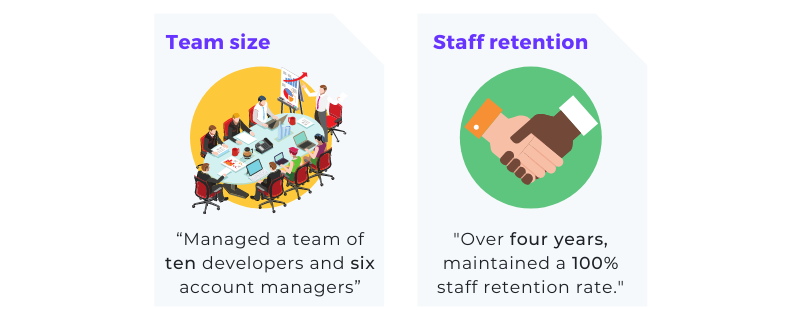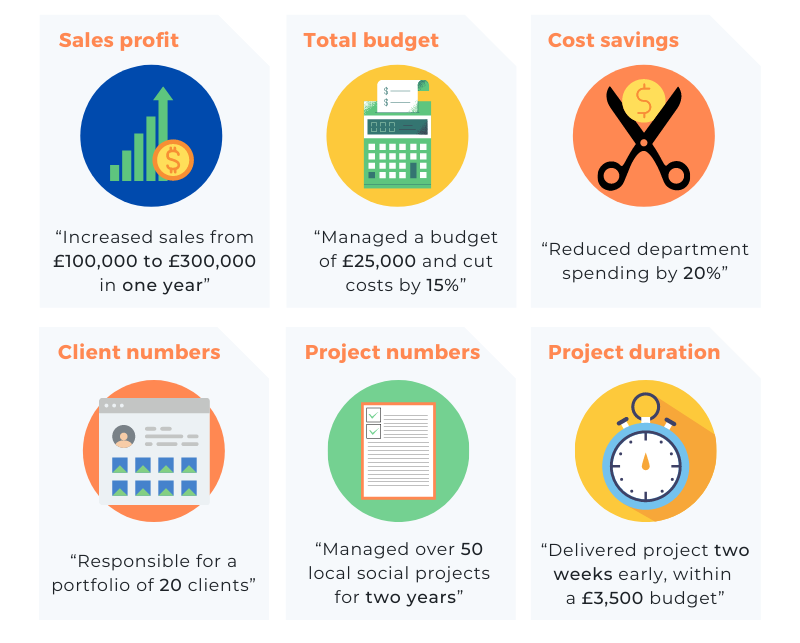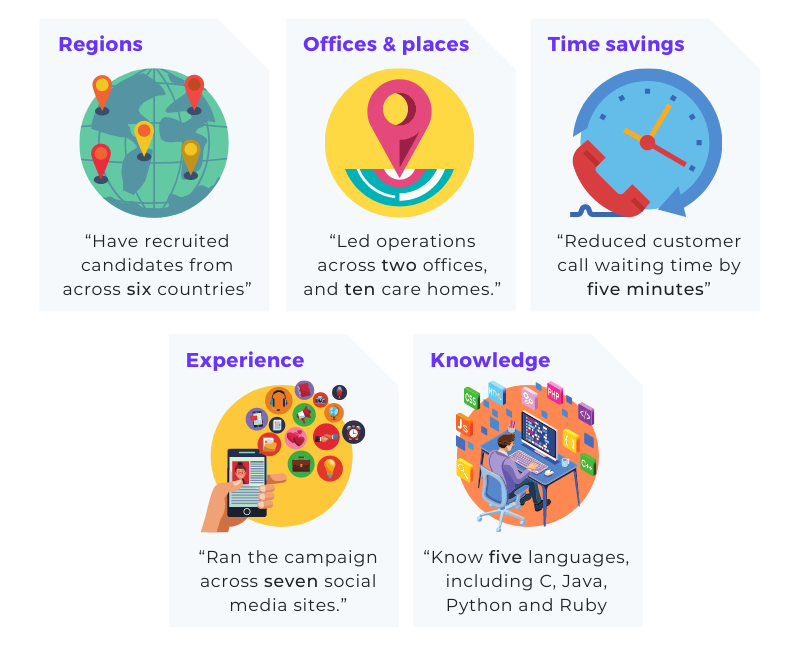Statistics, numbers and quantifiable data. Numbers are compelling.
More and more companies are asking to see figures on CV or resumes. It’s not rocket science – it’s the quickest way employers can see how you add value to your role.
For instance, if you were a sales consultant, you could add the percentage increase in sales you were personally responsible for over a series of months. This demonstrates your expertise and the monetary value you could bring to your new employer.
You’ll quickly realise that there are easy ways to collect this numerical evidence and measure it – making for some impressive figures!
How to find your key quantifiable data
There’s always something on your CV that can be enhanced with a number – no matter the industry you’re in.
For some industries, it’s obvious what to include. Work in sales or finance? Use metrics such as:
- Sales volume
- Market share
- Budgets
- Profitability
- Performance rank
- Customer satisfaction
- Clients retained
Such as: “Ranked as the number one salesperson for three consecutive months for sales performance.”
But what if you don’t work in these areas? Well, quantifiable data can be:
- Numbers
- Sizes
- Percentages
- Money
- Test scores
- Time
There’s a big variety to use and include, and all roles will have something you can turn into a figure. (We explore this in the next section).
One extra note – use a range if you don’t have specific numbers.
For instance, if you were a content marketing executive, you could write:
- “On average edited five to seven blogs per week”
- “Submitted five press releases every fortnight”
- “Managed a budget exceeding £25,000”
(We can all agree – this sounds better than just “wrote blogs, press releases and managed a budget”.)
What could I include?
Here is a list of quantifiable data that you could collect and add to your CV and next cover letter. We’ve collected them into subsections to help you find some good ideas quickly.
Staff management numbers
- Number of staff you have managed/supervised.
- Number of staff you have trained/coached/mentored.
- Percentage or number of staff promoted by you.
- Number of meetings you chair, including the number of delegates.
- Staff retention rate within the team you managed.*
(To find your staff retention rate: divide the number of employees that stayed with your company while you were there, by the number of employees you started with on day one. Then, multiply that number by 100 to get your employee retention rate.)

Project statistics
Multiple projects:
- The volume of accounts, clients, customers or projects you have managed.
- The percentage of accounts, clients or customers retained.
- Total budget you manage in your role.
- The total monetary value of contracts you have negotiated within a timeframe.
- The percentage of projects you’ve successfully delivered on time and/or within budget.
Individual projects:
- The revenue you have generated from a project.
- The number of people a project reached. (Size of audience, number of submissions/downloads, etc.)
- Project duration.
- The biggest budget for a project you managed.
- The largest monetary value of a contract you have negotiated.
- Percentage time or cost saved/reduced on a project or in a department.

Productivity and effectiveness data
- The number of locations, such as countries, towns, offices or stores, you have worked with (or managed) within your role.
- The volume of tasks you delivered in a given timeframe.
- Your response rate for queries.
- The number of sales calls you typically made in a given timeframe.
- The number of customers or clients you typically served within a given timeframe.
- Time reduced (or percentage decrease) for customer calls/waiting times/response times.
- Money saved from negotiations with suppliers.
- Increase in market share.
- Percentage of targets hit over a timeframe.
- Percentage of issues resolved over a timeframe.
- The number of different specialised programmes you understand and use in your role.

Personal development figures
- The number of times you’ve been promoted in a role.
- The number of awards or accolades you’ve won.
- Number of training courses you’ve attended.
- Number of new qualifications you’ve gained. (As a bonus, if you scored highly in your qualification, mention it.)

Quantifiable data is your way of tangibly proving that you know your stuff! Adding numbers to your current CV shouldn’t take you long with this list.
The next step is to start tracking your achievements at your current job. This way you’ll be ready when it’s time to update your CV again.
Got your CV sorted? Here’s how to write a cover letter that will land you your next job, and how to master the interview basics. Follow us on LinkedIn to get regular top tips for getting your next dream role.
Other Reads

4 Minute Read 08.12.20
CV Best practice
Found yourself out of work for the first time in a long time? We’ve launched the #GetHired Skills ...

2 Minute Read 08.12.20
Creating a good workspace for your job hunt
Found yourself out of work for the first time in a long time? We’ve launched the #GetHired Skills ...

10 Minute Read 26.07.21
How to answer "Why do you want this job?"
“Why do you want this job?” Oh boy, what a minefield of a question. 😟 Let’s bre...